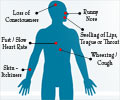Highlights
- Allergens activate the mast cells that respond by releasing histamine and other inflammatory factors.
- In rare cases, allergens trigger granule release simultaneously in mast cells throughout the body provoking anaphylactic shock.
- The motor protein Kinesin-1 that ransports secretory granules containing histamine and other inflammatory factors to the cell periphery along microtubuless, has been identified.
- Inhibiting a sub-unit of kinesin-1 called Kif5b reduces sensitivity to allergen-induced anaphylaxsis.
Mast cells are a type of white blood cell localized in most tissues of the body that fight off parasitic infections by releasing histamine and other inflammatory factors contained in secretory granules.
Allergens can also trigger granule release, and, if this happens simultaneously in mast cells throughout the body, it can provoke a life-threatening anaphylactic response. This leads to facial swelling, difficulty breathing, a drop in blood pressure, fainting and eventually death.
At present, the main treatment for anaphylaxis is to immediately inject patients with epinephrine using devices such as the EpiPen from the pharmaceutical company Mylan NV.
When mast cells are activated by allergens bound to immunoglobulin E antibodies, secretory granules move along microtubules to the periphery of the cells, where they can fuse with the plasma membrane and release their contents.
The researchers created mice in whom a key sub-unit of kinesin-1 called Kif5b was removed from the mast cells. They then became less sensitive to allergen-induced anaphylaxis.
"The fact that mice lacking Kif5b in their mast cells exhibited very low levels of passive, systemic anaphylaxis suggests that kinesin-1 could be a valuable new therapeutic target for controlling allergic reactions," Ménasché says.
Source-Medindia












